'I fear my neighbour' - the story behind US hate crimes
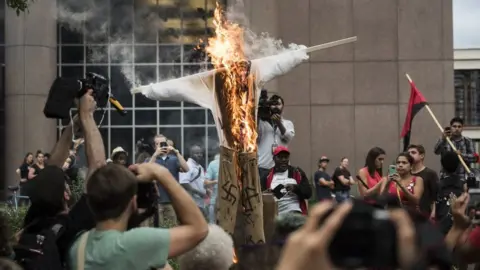 Getty Images
Getty Images"Hey, dumbass - the election is over... you lost on all accounts," said the letter that arrived in John Gascot's mailbox.
It accused him and his husband of living in a "gay house", adorned with a rainbow flag to "troll for queers".
And it was unsigned.
"I was angry. It was a cowardly act. My first reaction was 'I'm painting the house rainbow'", says Gascot, an artist and active member of the LGBT community in the state of Florida.
Three years ago, he moved with his partner of 20 years to St Petersburg, in Florida's Gulf Coast, and always felt that "people in this neighbourhood are very warm with each other".
Yet the anonymous "hate mail" that he got in December, just weeks after Donald Trump was elected president, put them on alert.
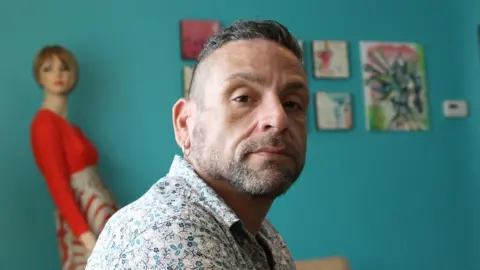 Valeria Perasso
Valeria Perasso"It was from a neighbour, somebody who sees us on a daily basis, because the letter details what times our lights go on and off, when we take our garbage out, when we put up our Christmas decorations," says Gascot.
Back then, the couple still had a "Vote for Hillary Clinton" poster in their front yard.
"Do we want to live fearing your neighbour? There's definitely an element of fear... We considered arming ourselves for protection."
The couple's story is one of many. St Petersburg is home to a vibrant LGBT community and threats motivated by gender identity have been mounting.
And many here - observers and victims alike - blame it on the current political climate.
"Since the election, there are people who have felt emboldened to speak up their hate or dislike," says Gascot.
"[Republicans] ran a campaign based on fear, how was this not going to happen?"
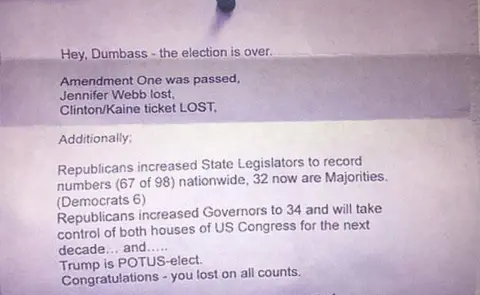

Double digits
Hate crimes have been in the spotlight in the US following the November election.
A study from the nonpartisan Center for the Study of Hate and Extremism, at the California State University, San Bernardino (CSUSB), revealed that there has been a double-digit spike in reported cases in many US metropolitan areas in 2016, a trend that seems to have continued.
In New York City, the uptick was 24%, the highest in over a decade. Chicago saw a 20% increase, it was 50% in Philadelphia and 62% in Washington DC - the largest increase among the 25 large cities surveyed in the CSUSB report.
Incidents range from serious physical attacks to racist graffiti and slurs, desecrations at synagogues and Jewish cemeteries, harassment of black Americans and threats towards immigrants, undocumented or otherwise. Abuses against Muslims and lesbian, gay, bisexual and transgender people accounted for much of that growth.
 Getty Images
Getty ImagesA week ago, violent clashes at a white supremacist rally in Charlottesville, Virginia, shocked the nation with a display of torches and Nazi flags. A woman was killed when a car ploughed into a crowd of counter-protesters.
And although the findings of the CSUSB study are partial - based on a small sample of cities, with data provided by some but not all state and local law enforcement agencies - it offers a glimpse into a trend noted in other surveys.
The Anti-Defamation League (ADL), for instance, reports that the number of anti-Semitic incidents surged more than one-third in 2016 and jumped 86% in the first quarter of 2017. ADL also tracked an 106% increase of hate crimes in schools between 2015 and 2016.
Inflamed passions during a racially tinged presidential campaign, as well as a willingness of victims to step forward, may be the forces behind the spike, researchers say.
By highlighting issues such as race, religion and national origin, the tone of the past US presidential election cycle could have exerted an influence on crime rates and media exposure, leading to "individuals who vary in motivation, from hardcore bigots to those just seeking a thrill" to take action, the Centre for the Study of Hate and Extremism's director Brian Levin told Reuters.
Many have drawn a connection between violent outbursts and the polarising rhetoric of the incumbent president - although statistics cannot prove direct correlation.
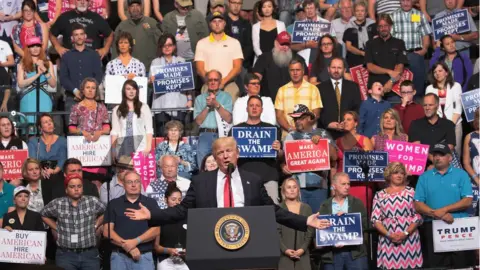 Getty Images
Getty ImagesDonald Trump repeatedly disparaged Mexicans during his presidential campaign.
"They're bringing drugs, they're bringing crime, they're rapists", he said in a speech in 2015, when he announced his candidacy.
Mr Trump also called for a "total and complete shutdown of Muslims entering the United States", although this statement was later removed from his campaign website. Seven days after taking office, he signed an executive order temporarily barring people from seven Muslim-majority countries to travel into the country.
The president was also heavily criticised for taking too long before condemning a US-wide rise in anti-Semitism, last February (he later said it was "horrible" and "has to stop") and, more recently, for blaming "both sides" for the violence at a white supremacist rally in Charlottesville.
While Mr Trump pledged to make pro-LGBT policy a matter of record, measures such as his unexpected ban on transgender people from serving in the military, last month, angered gay rights activists.
Many believe the political climate, as well as Vice-President Mike Pence's openly anti-LGBT stance, have emboldened social conservatives to express homophobic views, leading to an increase in hate crimes against sexual minorities.
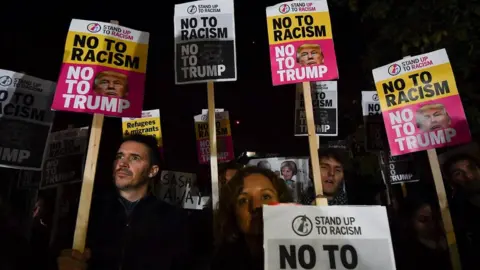 AFP / GETTY
AFP / GETTYA study undertaken in the three months after Election Day provides some evidence of a "Trump effect" of some sort.
The Southern Poverty Law Center (SPLC), an Alabama-based advocacy organisation that monitors extremism nationwide, measured 1,094 bias incidents between November 2016 and February 2017 as part of their #ReportHate project.
Of those, 37% openly referred to the president, his campaign slogans or policies. Another tracking effort, from liberal news site ThinkProgress, puts that figure at almost 42%.
And the fact that different organisations nationwide feel there is a need to compile a database of hate incidents is a sign of the times in itself, experts say.
The SPLC - which was founded by civil rights lawyers to monitor white supremacist organisations such as the Ku Klux Klan but later expanded its scope - has mapped hate groups operating on US soil: 917 across the mainland 48 states in 2016, up from 784 two years earlier.
California hosts the largest number, 79, followed by Florida, with 63.
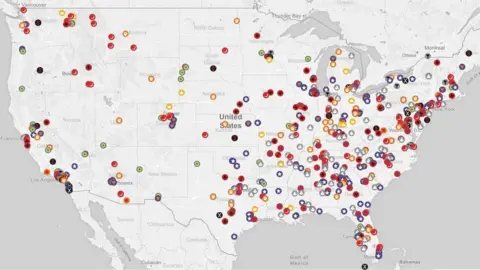 SPLC © Mapbox / OpenStreetMap
SPLC © Mapbox / OpenStreetMapThe SPLC has also been building a map of hate incidents, in which California, New York and Texas have the largest number of reported cases, followed at a distance by Florida.
Lacking statistical value, it relies on data provided by law enforcement agencies but also on field sources, news reports and personal accounts, not all of them verified, it nonetheless provides a snapshot of a seemingly upward trend.
The problem, the SPLC says, is that hate crimes are a national problem "but there's no reliable data on the nature or prevalence of the violence".

Hate crime data is notoriously difficult to gather.
The FBI, which is required to track these crimes and has been publishing related statistics since 1996, counts around 6,000 annually. But a June report from the Bureau of Justice Statistics estimates a total closer to 250,000.
One of the reasons for such a gap, experts say, is that law enforcement agencies aren't all required to report to the FBI, so their numbers may not make it into the national tally.
The other, is that a striking 54% of victims do not contact the police.
"Hate incidents do not seem to follow a distinct pattern, every minority is affected," says Heidi Beirich, director of SPLC's Intelligence Project.
And some types, Beirich says, are more underreported than others, "specially in areas where people feel insecure because they lack tight social networks".
Hover over the image to see figures for each type.

Keep the church safe
During a Sunday service at the King of Peace Metropolitan Community Church (MCC) in St Petersburg, doors remain locked to keep some 250 attendants safe.
This church, a Christian denomination that originated in 1968 in a living room in California and has now expanded to other countries, has an ethos of inclusiveness and openness. So the increased security measures - surveillance cameras, extra staff and protocols to respond in case of attack included - were introduced as a last resort.
"We had to put more security in place after our church got chalked with "MAGA" signs [an acronym for Trump's slogan Make America Great Again]," says pastor Candace Shultis, who has been in charge of St Pete's MCC branch for nine years.
The campaign slogan was written on the pavement just a week after the election, together with swastikas.
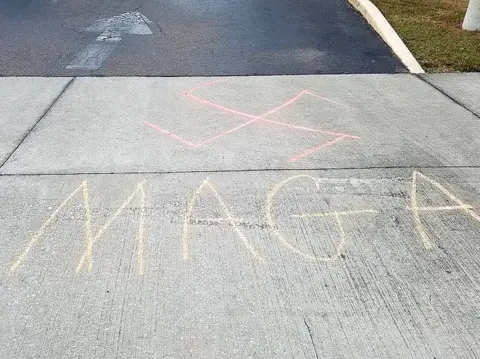 Candace Shultis
Candace Shultis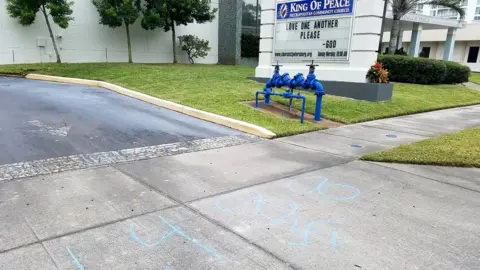 Candace Shultis
Candace Shultis"To see a swastika was shocking, and disheartening. We called the police to report it as a hate crime," says slender and short-haired Shultis, in her deep, calm tone.
One of the motives for the attack is likely to be the church's appeal for LGBT people, says Shultis, as MCC was originally founded as an outreach space for gay men when other denominations were less inclusive and tolerant.
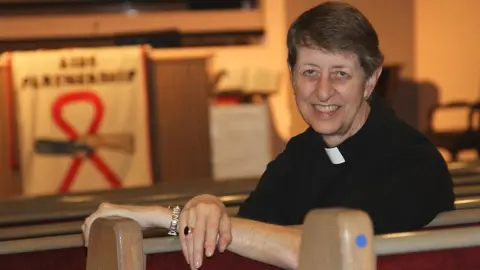 Valeria Perasso
Valeria PerassoChurches that perform same-sex marriages or advertise inclusivity have been targeted nationwide.
But down the road here in St Petersburg a legal firm was also targeted - with a sign outside offering "immigration advice"- as well as a paint store ("Maybe because many of our customers are Latino construction workers, or because our logo has many colours to promote our paints and they mistook it for a rainbow flag", says Daniel, the store manager).
"There was an undercurrent of racist attitudes during the Obama administration, this is not new," says Shultis. "People have now been given permission to spew out the hatred".
"Trump's candidacy show forth that part of the country that is extremely conservative. There are reasons to be fearful because these attacks are not always verbal, and let's not forget that in this country we have easy access to weapons".
Hover over the image to see figures for each location.

At the Sikh gurdwara
Among all minority groups, hate crimes against Muslims have probably been the most widely reported - a long-standing trend that spiked immediately after the 9/11 terror attacks. According to FBI data, there were 481 crimes in 2001, up from just 28 a year earlier.
A few years later the number of anti-Muslim violent incidents receded. But in 2015, during the early stages of the election cycle, a new surge was observed, with a 67% increase over the previous year according to researcher Brian Levin.
Between April and June 2017, advocacy group Council on American-Islamic Relations (CAIR) reported 72 cases of harassment and 69 hate crimes. Hate incidents in the first half of 2017 spiked 91% compared to the same period in 2016, they claim.
Anti-Muslim cases "now account for 4.4% of all reported hate crime even though Muslims are estimated to be only 1% of the population," wrote criminologist Brian Levin in a column for The Conversation.
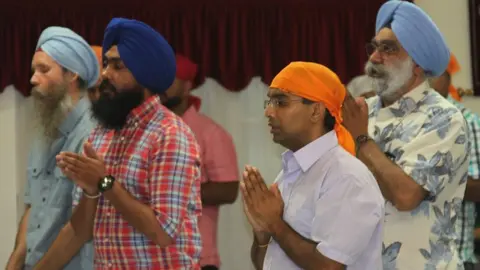 Valeria Perasso
Valeria PerassoOther minorities have perhaps got less media attention, yet they rank high as targets of hate attacks.
In the largest Sikh gurdwara close to St Petersburg - a house of worship and community centre in nearby Tampa, just across the bay- the Sikh community share their fears.
"Am I more careful? Yes, I am. I know I do look different, we trigger all sorts of stereotypes when we come into the room," says young IT professional Satpreet Singh.
Founded in Punjab five centuries ago, Sikhism establishes some personal grooming practices that set their adherents apart. Observant male Sikhs don't ever cut their hair and cover it with a turban, while many also typically refrain from shaving.
There are some 500,000-700,000 Sikhs living in the US. Misconceptions led many to believe that they are Muslims.
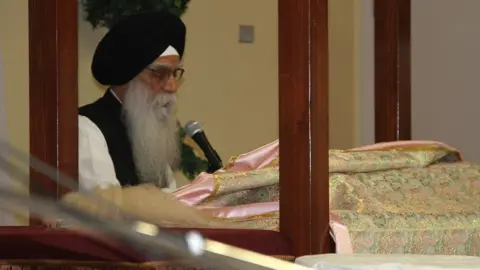
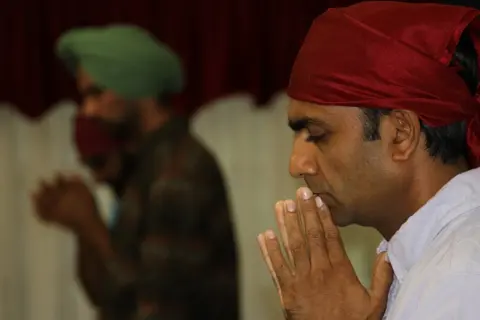 Valeria Perasso
Valeria PerassoThe outburst is not new - it was fuelled by the 9/11 attacks and led to episodes of extreme violence such as the murder of a Sikh in Arizona and the so-called massacre of Oak Creek, when a white supremacist opened fire on worshippers at a gurdwara in Wisconsin, killing six.
Satpreet himself escaped a shooting years ago, while being driven around by his turban-clad father.
As with Muslims, hate crimes against Sikhs slowed down for some years but went up again recently, experts warn.
Advocacy group South Asian Americans Leading Together (SAALT) documented over 200 incidents after the last election campaign kicked off.
"It's alarming, the trend that followed 9/11 is re-emerging," says Singh.
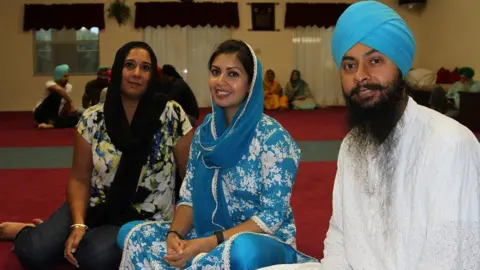 Valeria Perasso
Valeria Perasso"It is hard because it can lead you to live in fear of doing even the most basic things, like going around your neighbourhood."
With his wife, Hardeep Khur, they stopped going into "areas that are more conservative."
"The other day we were just going to a doughnut shop that is located in a very white area. First thing that came to my mind was 'you know what? Let's go to another doughnut shop elsewhere'", says Khur, who is Canadian and moved to Florida eight years ago.
Some of the younger worshippers in the gurdwara have gone a step further: they have cut their hair and stopped wearing a turban altogether to avoid being singled out - even though it goes against a basic mandate of their religion.
"We cannot educate people when they call you names and threaten you, because they are not open to being educated. You just have to be aware and protect yourself," says Singh.

Undocumented and afraid
Hispanics in St Petersburg do not have it easier either. Even though they represent almost a quarter of the overall population in Florida, here they are a small minority of less than 7%.
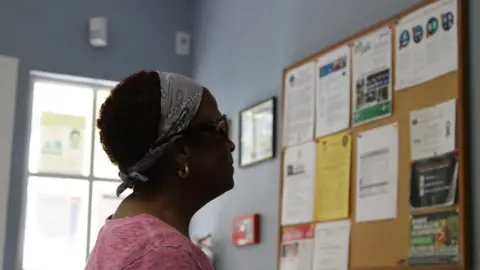
Following Trump's promises to build a wall along the US-Mexico border, anti-immigrant harassment has become the most reported type of hate crime, according to SPLC statistics.
"We've seen people's feelings reverting to fear," says Raymond Croze, Spanish Outreach officer in a local police department.
"We have seen an increase in wage theft. People who work in gardening, for example, and get abuse from bosses who make them work and then don't pay them their wages. We intervene to make sure they do get their money," he says.
"Build the wall" and "Go home" signs, swastikas and Nazi messages were found on the walls of a Spanish church and on lamp posts in a nearby beach. Croze referred all cases up to the FBI.
"Undocumented immigrants often fear that reporting these crimes will reveal their status, which leads to an underreporting of incidents," Croze says.
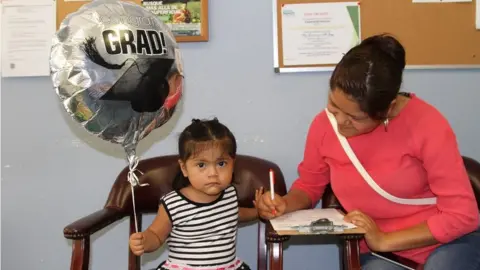

Contested numbers
In a polarised climate, it comes as no surprise that some of these numbers are being contested. Critical voices reject the notion of a spike in hate crimes in Trump's America.
They argue that the proliferation of hate groups is a phenomenon that started before his candidacy - and as early as the turn of the century, driven in part by a rejection of Latino immigration and by US Census projections that show whites will no longer be the demographic majority in the country by 2044.
Hence, Trump supporters could say, it cannot be established that increased rates of bias incidents come as a result of the campaign's inflammatory speech.
In fact, the current number of hate groups in operation measured by the SPLC is still well below its all-time peak, in 2011.
Also, the SPLC has been criticised for going too far in labelling too many groups and individuals as extremists, as well as for not having enough data over a long period of time to project trends that are solid.
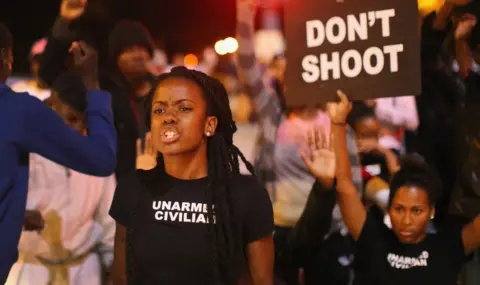 Getty Images
Getty ImagesOthers say that attacks against minority groups have been long happening in large numbers without anyone watching.
Historically, FBI reports show that half of all hate crimes have been racially charged and the majority have targeted black people - in 2015, those incidents far outnumbered anti-white or anti-Hispanic cases, for example.
The activist movement Black Lives Matter says African Americans are victims "on a regular, daily basis".
"While the president and his advisors significantly contribute to the lack of safety that black folks experience and are accountable for incredible harms inflicted on communities of colour, they are mere symptoms of white supremacy and xenophobia, which are far greater enemies than just one administration," they wrote in a Facebook statement after the violent rally in Charlottesville.
So is it just a matter of hate crimes now having wider media coverage?
Some believe that is the case.
"While it's easy for some to blame Trump for all acts of bigotry, we should discern what's new from what we're simply noticing for the first time," wrote Mark Oppenheimer in the Washington Post.
"For those who believe that Trump poses a threat - to Jews, all other minorities and all Americans - it's important that we get our facts right. If danger is on the rise, we have to be looking in the right direction",
Researcher Brian Levin doesn't agree.
"I don't think we can just explain away the increase with increased reporting," he says.

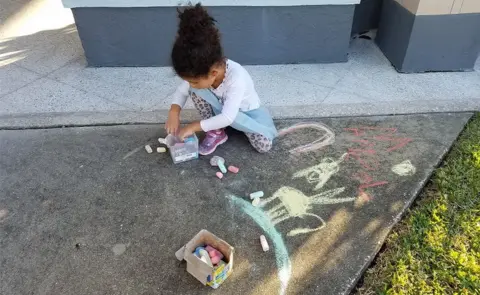 Candace Shultis
Candace ShultisMore numerous or more visible, hate crimes have also inspired a counter-reaction at community level.
Support networks have grown in some minority neighbourhoods. The SPLC has published a "community response guide", with practical advice: pick up the phone, sign a petition, research your rights, and the list goes on.
For Pastor Shultis, relief came when the church's neighbours stood up. Families brought their children to draw rabbits, dogs and butterflies in colourful chalk over the swastikas.
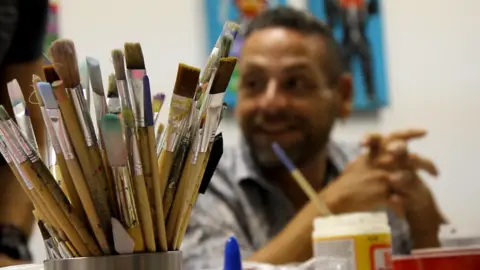 Valeria Perasso
Valeria Perasso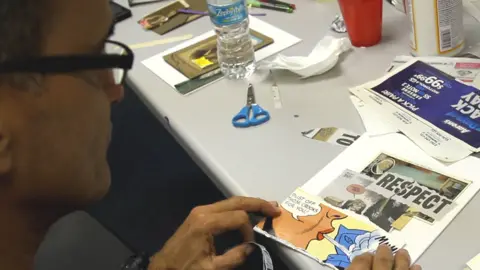
While artist John Gascot felt he needed to "turn something ugly into something nice" after the hate letter.
He decided to host free workshops for LGBT youth, to provide a safe space for often-marginalised students in fear of expressing themselves.
"Art helps, but this is not about art at all. It's about helping them feel comfortable to be who they are, giving the future generations what we didn't have," says Gascot.
"This election has taken a lot of people out of complacency, and that's a good thing after all".
.
